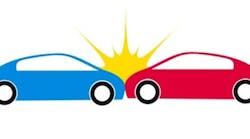In the Control Talk blog post "What Does a Car Collision Teach us about Process Control," Greg McMillan uses a video of a car crash to explain the complexities of the concept of dead time. He says, "The use of the term ‘process dead time' can mislead us in terms of recognizing the many sources of dead time. Also, we don't often take into account the profound effect of the speed and the entry point of a disturbance into the process."
He summarizes the video this way: "The total loop dead time is the sum of the time to recognize the impending collision (measurement delay); to make a decision (controller execution delay); to move the leg to the brake (final control element delay); and to noticeably decelerate after the brake is applied (process delay). The disturbance is unmeasured because the car swerving around the line of traffic and running the red light is unseen and unpredictable. Therefore, feed-forward control is not possible, and the driver is relying totally on feedback control."
Javier Galvez Gamboa comments: A good challenge is to improve car process dynamics, and reduce the final control time-element delay. On the other hand, if you take into consideration the cell phone or other distractions for the driver, some accidents can be avoided. I like the way that you describe the whole problem as a control loop. Very interesting.




